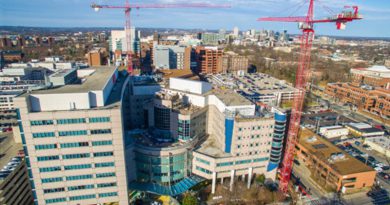What is Hypoplastic Left Heart Syndrome (HLHS)?
Published on June 13th, 2018 by Christina Echegaray.
Congenital heart conditions are present when a child is born. Doctors and surgeons with the Pediatric Heart Institute at Monroe Carell Jr. Children’s Hospital at Vanderbilt provide comprehensive, quality care to children with a variety of congenital heart conditions. Hypoplastic left heart syndrome (HLHS) is one of the many heart conditions they treat.
Congenital heart disease is sometimes diagnosed while the baby is in utero during a gestational ultrasound. Newborns not diagnosed in the womb who exhibit symptoms — such as shortness of breath, rapid breathing, pounding heart, bluish skin from lack of circulation, cold arms and legs, weak pulses, difficulty feeding and lethargy — may have an echocardiogram to explore for heart defects.
In patients with HLHS, the right side structures of the heart are normal, but the left side structures are hypoplastic, or small, though the extent of the defect can vary from patient to patient. The aortic and mitral valves can be small or absent. Also, the left ventricles vary in size, from quite small to near normal size. The defects affect normal blood flow through the heart, resulting in a lack of oxygen-rich blood to the rest of the body.
HLHS accounts for 2 to 3 percent of all congenital heart disease and has a prevalence rate of about two to three cases per 10,000 live births, according to UptoDate, an evidence-based, physician-authored clinical decision support resource used by many doctors.
“This defect is universally fatal without surgery,” said Ann Kavanaugh-McHugh, MD, associate professor of Pediatrics and director of Vanderbilt’s Fetal Cardiology Program. “Patients require lifesaving surgery which will either consist of single ventricle palliation (called the Norwood) or initial transplantation.”
“When a surgery doesn’t ‘fix’ things it is a palliation (seeks to provide relief from symptoms). At the end of the three operations that make up single ventricle palliation, the heart is a single ventricle, not the two pump heart that the rest of us have. The initial surgery, the Norwood repair, is done usually in the first week of life, the Glenn at four to six months and the Fontan generally at about 3 years of age.”
Each procedure can require a lengthy stay in the hospital with Norwood being about 40 days; the Glenn and Fontan about nine days each, though recovery time can vary from patient to patient. Some patients have multiple readmissions in between surgeries because they are medically more fragile. If a heart transplant is needed, the wait in the hospital can average two to four months, sometimes longer.
Often during that time, the heart families will bond.
“Families draw strength from each other during their time in the hospital,” said Kavanaugh-McHugh. “They become communities of support for one another as they are facing the same challenges. Families look to one another for information and are tremendous supports for each other.” Doctors know data. It is not the same as speaking with someone who has ‘walked the walk.’ We encourage families to support each other.”
– by Christina Echegaray


